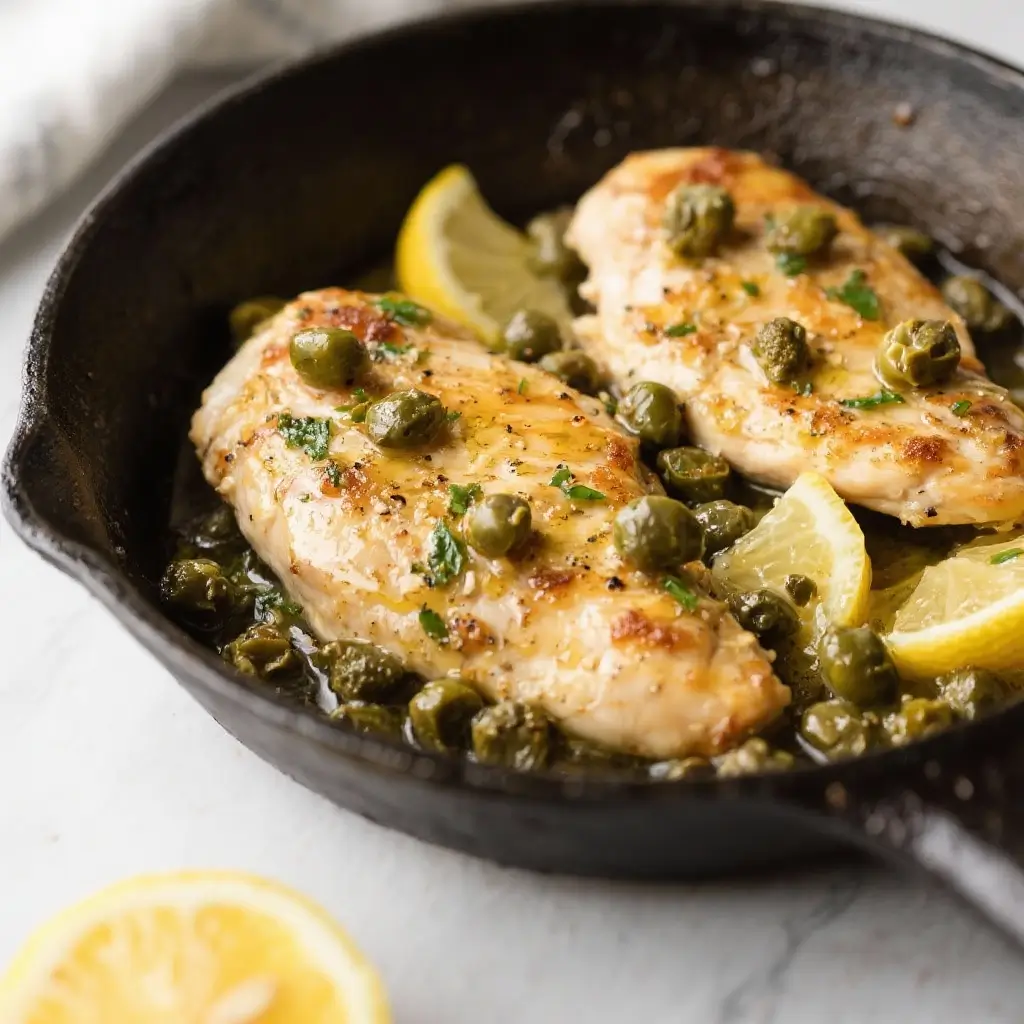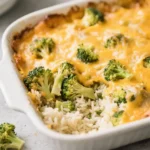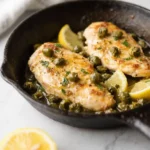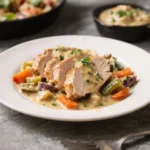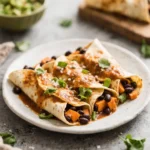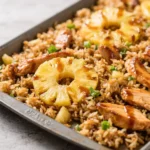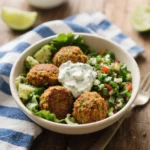One-Skillet Chicken Piccata with Capers & Lemon
There’s something undeniably comforting and elegant about a well-prepared chicken dish that comes together in a single skillet. One-Skillet Chicken Piccata with Capers & Lemon is exactly that—a classic Italian-American favorite that marries tender chicken breasts with the bright tang of lemon, briny capers, and a rich, buttery sauce—all cooked in one pan for maximum flavor and minimal cleanup. Whether you’re cooking for a weeknight dinner or impressing guests at a weekend gathering, this recipe delivers restaurant-quality results with home-cooked warmth. With its vibrant flavors, simple ingredients, and streamlined preparation, it’s no wonder this dish has earned a permanent spot in the hearts (and kitchens) of food lovers everywhere.
The History of Chicken Piccata
Chicken Piccata traces its roots back to Italy, where the term “piccata” refers to a style of cooking that involves slicing meat thinly, sautéing it, and serving it with a sauce typically made from lemon juice, wine, and capers. While the original version often used veal—known as Vitello alla Piccata—chicken became a popular substitute in American-Italian cuisine due to its affordability, availability, and milder flavor profile. The dish gained widespread popularity in the United States during the mid-20th century, particularly in Italian-American communities across cities like New York, Philadelphia, and Chicago. Over time, the recipe evolved to include variations such as different herbs, types of wine, and even cream-based sauces, but the core components—lemon, capers, garlic, and white wine—have remained constant. Today, One-Skillet Chicken Piccata stands as a testament to the beauty of simplicity, showcasing how just a few high-quality ingredients can come together to create something truly extraordinary.
Ingredients Breakdown: What Makes This Dish Shine
The magic of Chicken Piccata lies in its balance of acidity, saltiness, richness, and freshness. Each ingredient plays a crucial role in building layers of flavor:
- Chicken Breasts: Boneless, skin-on chicken breasts are ideal—they stay juicy during cooking and develop a golden crust when seared properly. You can also use pounded cutlets for quicker cooking.
- Flour: A light dredge in all-purpose flour helps create a delicate crust on the chicken and thickens the sauce slightly without making it heavy.
- Lemon: Fresh lemons are essential. The juice provides tartness, while the zest adds aromatic brightness. Always use fresh—not bottled—to avoid bitterness and preserve vibrancy.
- Capers: These pickled flower buds from the Mediterranean add a salty, briny pop that cuts through the richness of the butter and complements the lemon perfectly. Rinse them briefly if they’re packed in salt; otherwise, just drain if in vinegar.
- Dry White Wine: Choose a crisp, dry wine like Pinot Grigio, Sauvignon Blanc, or Vermentino. It deglazes the pan and brings depth and complexity to the sauce. Avoid sweet wines, which can throw off the balance.
- Chicken Stock: Adds savory umami and body to the sauce. Use low-sodium so you can control the salt level.
- Garlic: Minced fresh garlic infuses the oil with aroma and enhances the overall savoriness.
- Butter: Unsalted butter finishes the sauce, giving it a silky texture and luxurious mouthfeel. Some recipes call for cold butter added at the end (a technique called monter au beurre) to emulsify and enrich the sauce.
- Parsley: Fresh flat-leaf parsley adds color, freshness, and a mild herbal note. It’s best added at the end to preserve its vibrancy.
- Olive Oil: Used for searing, it lends a fruity base note and helps prevent the butter from burning.
- Salt & Pepper: Essential for seasoning each layer of the dish. Season the chicken well before cooking for the best flavor.
Step-by-Step Recipe: How to Make One-Skillet Chicken Piccata
Follow these detailed steps to achieve perfectly seared chicken and a glossy, balanced lemon-caper sauce every time.
- Prep the Chicken: Start with 4 boneless, skin-on chicken breasts (about 6–7 oz each). If they’re very thick, butterfly them or gently pound them to an even ¾-inch thickness using a meat mallet or rolling pin. This ensures even cooking. Pat them dry with paper towels—this is critical for achieving a good sear.
- Season and Dredge: Season both sides of the chicken generously with kosher salt and freshly ground black pepper. Place about ½ cup of all-purpose flour in a shallow dish and lightly dredge each breast, shaking off excess. Set aside on a plate.
- Heat the Skillet: Heat a large, heavy-bottomed skillet (preferably stainless steel or cast iron) over medium-high heat. Add 2 tablespoons of olive oil and 1 tablespoon of unsalted butter. Wait until the butter melts and just begins to foam—but don’t let it brown.
- Sear the Chicken: Carefully place the chicken breasts in the hot skillet, skin-side down. Do not overcrowd the pan; work in batches if necessary. Sear for 5–6 minutes until deeply golden brown and crispy. Flip and cook for another 4–5 minutes until cooked through (internal temperature should reach 165°F). Transfer to a plate, tent loosely with foil, and set aside.
- Build the Sauce: In the same skillet (don’t clean it—those browned bits are flavor gold!), reduce the heat to medium. Add 1 tablespoon of olive oil if needed, then stir in 3–4 minced garlic cloves. Cook for 30 seconds until fragrant—do not let it burn.
- De-glaze with Wine: Pour in ½ cup of dry white wine, scraping the bottom of the pan with a wooden spoon to lift all the flavorful browned bits (this is called fond). Let the wine simmer and reduce by half, about 3–4 minutes.
- Add Stock and Simmer: Stir in ¾ cup of low-sodium chicken stock, 2 tablespoons of capers (rinsed and drained), and the zest of one lemon. Bring to a gentle simmer and cook for 5 minutes to allow the flavors to meld and the sauce to reduce slightly.
- Incorporate Lemon Juice: Remove the skillet from heat and stir in the juice of one whole lemon (about ¼ cup). Taste and adjust—add more lemon if desired, but be careful not to make it too tart.
- Finish with Butter and Herbs: Return the skillet to low heat. Swirl in 3 tablespoons of cold unsalted butter, one piece at a time, letting each melt before adding the next. This creates a smooth, velvety sauce. Stir in ¼ cup of chopped fresh parsley.
- Return Chicken to Pan: Gently place the chicken breasts back into the skillet, nestling them into the sauce. Spoon the sauce over the top and let them warm through for 1–2 minutes.
- Serve Immediately: Plate the chicken and generously spoon the sauce over each piece. Garnish with extra lemon slices, a sprinkle of parsley, and additional capers if desired.
Tips for Perfect Chicken Piccata Every Time
- Don’t Skip the Dredging: Even a light coating of flour prevents sticking, promotes browning, and helps thicken the sauce naturally.
- Use Room-Temperature Chicken: Cold chicken straight from the fridge won’t sear properly. Let it sit out for 15–20 minutes before cooking.
- Control the Heat: Too high, and the butter burns; too low, and the chicken steams instead of searing. Medium-high is ideal.
- Resist Moving the Chicken: Once the chicken hits the pan, leave it alone for at least 5 minutes to develop a proper crust.
- Balance the Acid: Lemon can vary in tartness. Always taste the sauce before serving and adjust with a pinch of sugar or a splash of stock if it’s too sharp.
- Don’t Overcook the Chicken: Carryover cooking happens after removal from heat. Pull the chicken when it reaches 160°F—it will rise to 165°F while resting.
- Use Fresh Ingredients: Bottled lemon juice, dried parsley, or old wine will compromise the dish. Fresh is non-negotiable here.
- Rest the Chicken: Allowing the chicken to rest briefly after searing keeps it juicy when sliced.
- Serve with Absorbent Sides: This sauce is too good to waste. Pair with pasta, mashed potatoes, risotto, or crusty bread to soak it up.
Variations and Customizations
While traditional Chicken Piccata is timeless, feel free to experiment with creative twists:
- Creamy Piccata: For a richer version, stir in 2–3 tablespoons of heavy cream or mascarpone at the end for a luscious, velvety sauce.
- Herb-Infused: Add fresh thyme, rosemary, or oregano along with the garlic for deeper herbal notes.
- Spicy Kick: Introduce red pepper flakes (¼ tsp) when sautéing the garlic for a subtle heat.
- Seafood Swap: Try this method with thin-cut veal, pork scallopini, or even firm white fish like halibut or cod.
- Gluten-Free Option: Replace flour with rice flour or a gluten-free all-purpose blend. Ensure your stock and wine are certified GF.
- Dairy-Free Version: Substitute butter with vegan butter or omit it entirely, using extra olive oil and a touch of cornstarch slurry to thicken the sauce.
- Extra Vegetables: Sauté sliced mushrooms, cherry tomatoes, or baby spinach in the pan before adding wine for a heartier meal.
- Lemon Confit Twist: Use preserved lemon peel (rinsed) instead of zest for a deeper, fermented citrus flavor.
Health Considerations and Nutritional Value
One-Skillet Chicken Piccata can be part of a balanced diet when prepared thoughtfully. Here’s a nutritional breakdown per serving (1 chicken breast with sauce, without sides):
- Calories: ~400–450 kcal
- Protein: ~35–40g (excellent source)
- Fat: ~25g (mostly from healthy fats in olive oil and butter)
- Saturated Fat: ~8–10g (moderate—can be reduced with less butter)
- Carbohydrates: ~10–12g (primarily from flour and wine)
- Sodium: ~600–800mg (varies based on stock and capers—rinse capers and use low-sodium stock to reduce)
- Vitamin C: High from lemon juice—supports immunity and iron absorption.
- B Vitamins: Found in chicken and liver-supportive nutrients.
Healthy Modifications:
- Use skinless chicken breasts to lower fat and calories.
- Reduce butter to 1–2 tablespoons and increase olive oil for heart-healthy monounsaturated fats.
- Thicken sauce with a cornstarch or arrowroot slurry instead of flour for a lighter texture.
- Boost fiber and nutrients by serving over quinoa, farro, or zucchini noodles.
- Limit wine or replace with extra lemon juice and veggie broth if avoiding alcohol.
Ingredients
- 4 boneless, skin-on chicken breasts (6–7 oz each), pounded to ¾-inch thickness
- Kosher salt and freshly ground black pepper
- ½ cup all-purpose flour (or gluten-free alternative)
- 3 tablespoons olive oil, divided
- 2 tablespoons unsalted butter, divided
- 4 garlic cloves, minced
- ½ cup dry white wine (e.g., Pinot Grigio)
- ¾ cup low-sodium chicken stock
- 2 tablespoons capers, rinsed and drained
- Zest and juice of 1 large lemon (about ¼ cup juice)
- ¼ cup fresh flat-leaf parsley, finely chopped
Directions
- Season chicken breasts with salt and pepper on both sides. Dredge lightly in flour, shaking off excess.
- In a large skillet over medium-high heat, combine 2 tbsp olive oil and 1 tbsp butter. Once hot and shimmering, add chicken skin-side down. Sear 5–6 minutes until golden brown. Flip and cook 4–5 minutes more until internal temperature reaches 165°F. Transfer to a plate and cover loosely with foil.
- Reduce heat to medium. Add remaining 1 tbsp olive oil to the skillet. Add garlic and sauté 30 seconds until fragrant.
- Pour in white wine, scraping up browned bits. Simmer 3–4 minutes until reduced by half.
- Stir in chicken stock, capers, and lemon zest. Simmer 5 minutes to meld flavors.
- Remove from heat. Stir in lemon juice.
- Return to low heat. Whisk in remaining 1 tbsp butter and chopped parsley until sauce is glossy.
- Nestle chicken back into the skillet. Spoon sauce over each piece and warm 1–2 minutes.
- Serve immediately with extra sauce, lemon wedges, and parsley garnish.
FAQ
Can I make Chicken Piccata ahead of time?
Yes, though it’s best served fresh. You can prep ingredients in advance—slice and season chicken, mince garlic, juice lemons. Fully cooked chicken can be refrigerated for up to 2 days and reheated gently in the sauce.
Why is my sauce too sour?
Overly tart sauce usually comes from too much lemon juice or an acidic wine. Balance it with a pinch of sugar, a splash of stock, or a small pat of butter to mellow the flavor.
Can I freeze Chicken Piccata?
It’s not recommended due to the dairy and fresh herbs, which may separate or discolor upon thawing. However, the sauce (without butter) can be frozen separately for up to 1 month.
What wine pairs well with Chicken Piccata?
A crisp, acidic white wine like Sauvignon Blanc, Pinot Grigio, or Vermentino complements the lemony sauce beautifully. Serve chilled.
Can I use chicken thighs instead?
Absolutely! Boneless, skin-on thighs work well and offer a richer, juicier texture. Adjust cooking time as needed (may take 1–2 minutes longer).
How do I prevent the sauce from breaking?
Avoid boiling after adding butter. Keep the heat low and whisk gently. If the sauce separates, remove from heat, cool slightly, and whisk in a teaspoon of cold water or stock to re-emulsify.
Are capers necessary?
They’re traditional and highly recommended for authentic flavor, but you can substitute with chopped green olives or omit if unavailable. However, the dish won’t be true “piccata” without them.
Summary
One-Skillet Chicken Piccata with Capers & Lemon is a vibrant, restaurant-worthy dish that combines tender seared chicken with a zesty lemon-caper sauce, all made in a single pan for easy cleanup. Packed with bold Mediterranean flavors and ready in under 30 minutes, it’s a perfect balance of elegance and simplicity for any occasion.
